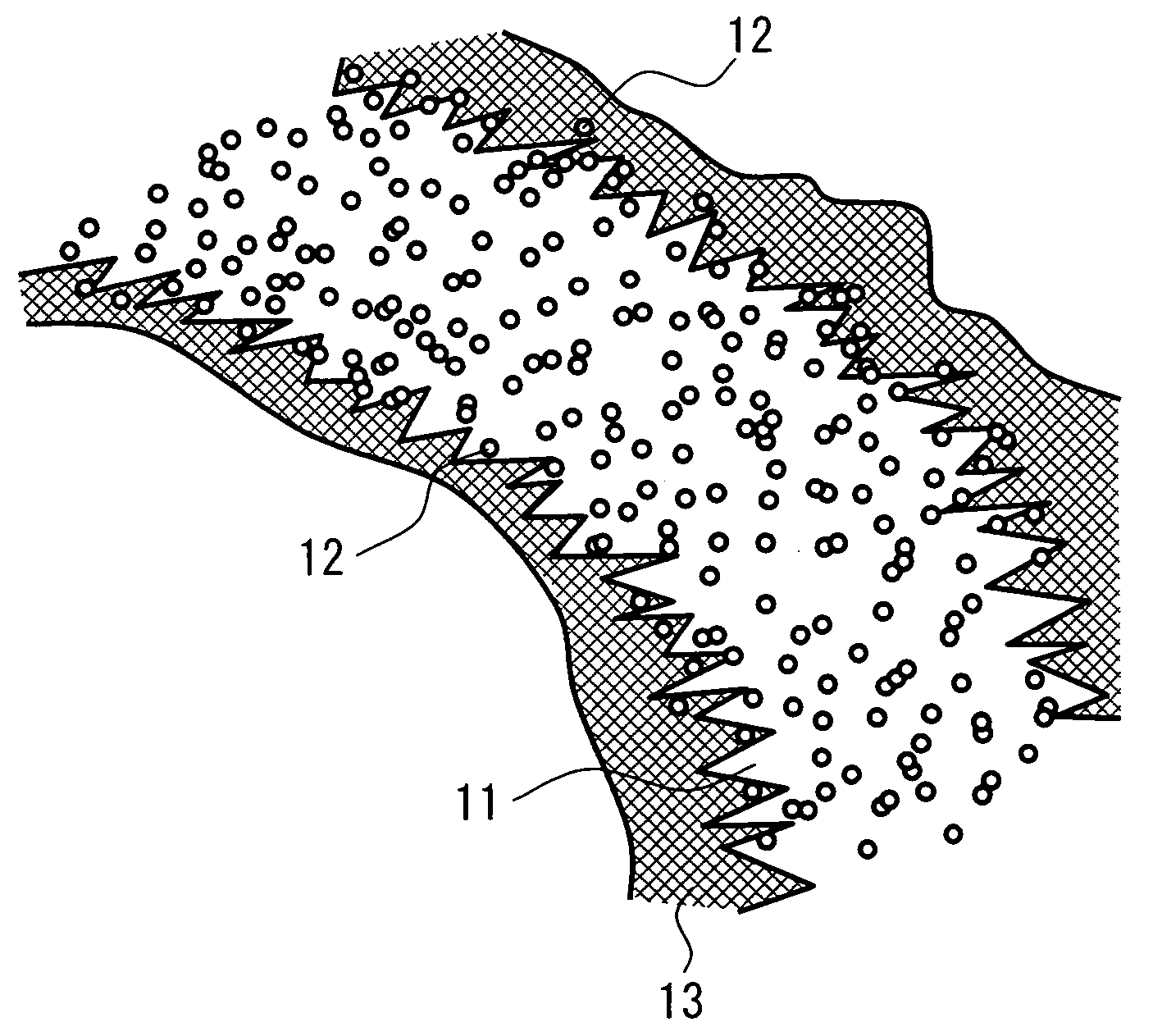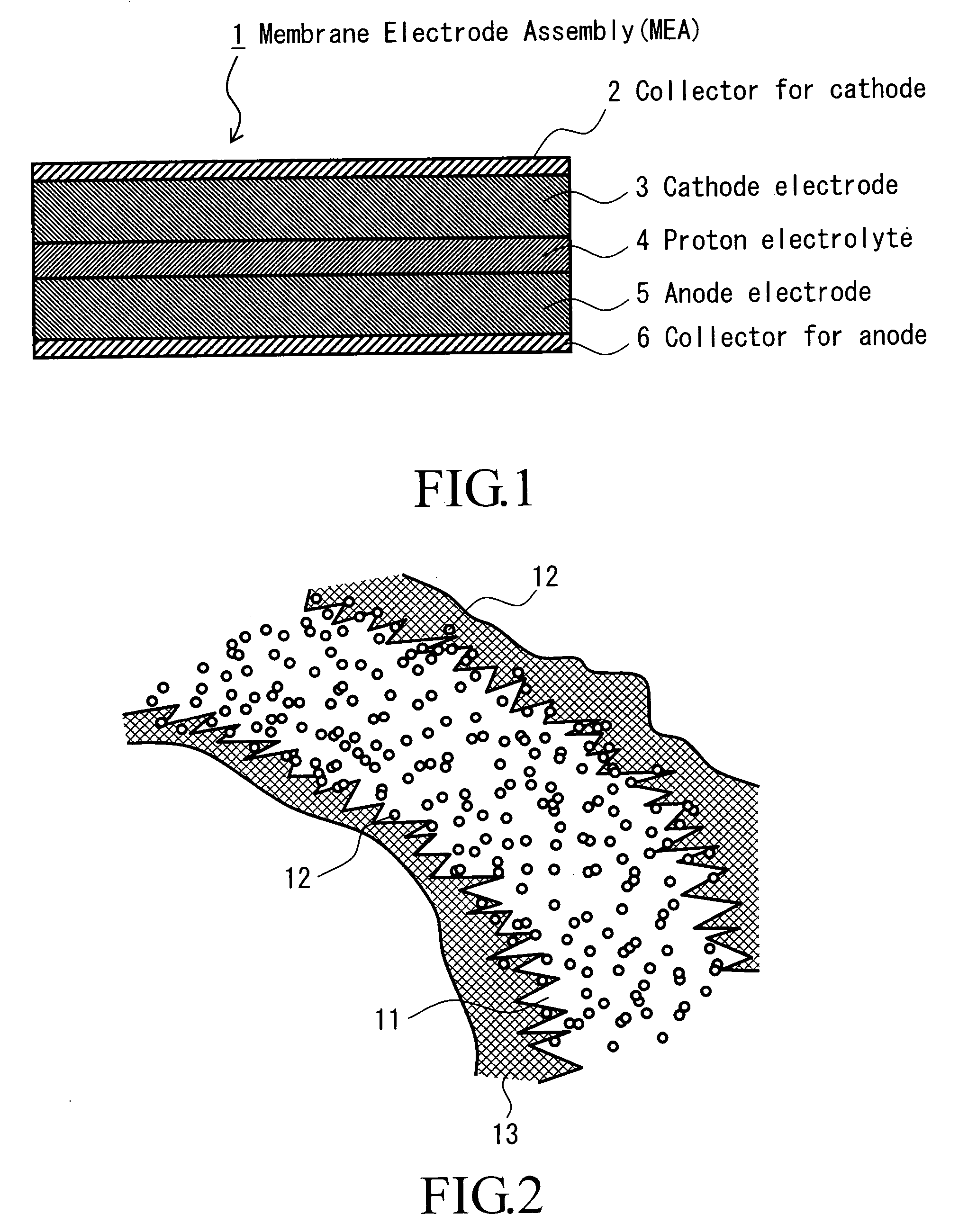Manufacturing methods of catalysts for carbon fiber composition and carbon material compound, manufacturing methods of carbon fiber and catalyst material for fuel cell, and catalyst material for fuel cell
a technology of carbon fiber and composition, which is applied in the direction of cell components, non-metal conductors, sustainable manufacturing/processing, etc., can solve the problems of insufficient gas diffusion, large electrode efficiency cannot be obtained, and fuel is partly wasted
- Summary
- Abstract
- Description
- Claims
- Application Information
AI Technical Summary
Benefits of technology
Problems solved by technology
Method used
Image
Examples
first embodiment
(Catalyst Material for First Fuel Cell)
[0034] Catalyst material for the first fuel cell of the present invention is characterized in that it includes carbon fibers in a mean diameter in the range of 100˜1000 nm and a specific surface area according to BET method in the range of 200˜500 m2 / g and
[0035] Catalyst particles containing the first metallic element (catalyst metallic element for fuel cell) comprising at least one of Pt and Ru and the second metallic element (elements other than the first metallic element) of less than 30 weight %.
[0036] According to such catalyst materials, it is possible to secure an electronic conduction path by thoroughly contacting carbon fibers each other and increase catalyst carrying amount. As the result, the output characteristic of fuel cells equipped with an anode electrode containing such catalyst material or a cathode electrode containing catalyst material can be improved.
[0037] The reason for why mean diameter of carbon fiber is limited to...
second embodiment
[0306] Next, another embodiment of this invention will be explained.
[0307] For example, in a fuel cell using methanol and water as fuel, liquid fuel is supplied to an anode electrode. On the other hand, an anode electrode made of porous materials is used in order to efficiently use catalysts in the electrode.
[0308] When liquid fuel reaches he proton conductive membrane by passing through the pore in the anode electrode, liquid fuel is transmitted to the proton conductive membrane and arrives at the cathode. As a result, fuel reacts directly with oxygen supplied to the cathode electrode and the cell may not function as a cell.
[0309] This embodiment resolves the said problem and a cross-sectional view of this embodiment is shown and explained below.
[0310] An electrode shown in FIG. 6 has a laminated catalytic layer formed on the surface of a collector 31 by sequentially laminating a catalytic layer 32 (hereinafter, called as a sparse catalytic layer) having large pores or a high p...
embodiment 1
[0329] Weighing nickel oxide in a mean particle size of primary particle 50 nm (Kojundo Chemical Laboratory: NI004PB, Purity 99.9%) and copper oxide (Kanto Kagaku made Trade Name: JIS Special Class Powder) so that the atomic ratio of Ni and Cu after reduced becomes 1:1, and mixing δ-phase alumina (Nippon Aerosil) in a mean particle size 30 nm to 5 volume % to the volume of Ni an Cu, raw material powder was manufactured.
[0330] Then, mixed power comprising 3 kinds of powders of nickel oxide, copper oxide and alumina are mixed and pulverized for 1 days using a planetary ball mill comprising a alumina ball and a container.
[0331] After mixing, put the powder in a crystal made boat and set in a tubular furnace. Then, reduce the inside of the tubular furnace by supplying a 1:1 mixed gas of hydrogen and argon mixed at 100 ml per min. and the temperature was increased by 10° C. / min. up to 200° C. and held for 10 min. Thereafter, changing the mixing rate of gas gradually to 100% hydrogen ga...
PUM
| Property | Measurement | Unit |
|---|---|---|
| particle size | aaaaa | aaaaa |
| particle size | aaaaa | aaaaa |
| mean primary particle size | aaaaa | aaaaa |
Abstract
Description
Claims
Application Information
 Login to View More
Login to View More - R&D
- Intellectual Property
- Life Sciences
- Materials
- Tech Scout
- Unparalleled Data Quality
- Higher Quality Content
- 60% Fewer Hallucinations
Browse by: Latest US Patents, China's latest patents, Technical Efficacy Thesaurus, Application Domain, Technology Topic, Popular Technical Reports.
© 2025 PatSnap. All rights reserved.Legal|Privacy policy|Modern Slavery Act Transparency Statement|Sitemap|About US| Contact US: help@patsnap.com



